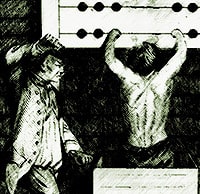"Give me a mongoloid nut that has been beating something with a stick in his basement for six moths over a graduate of one of these escrima programs any day. I'm betting on that guy! Even the stick-gods [Rico and Aaron] that murdered us, they did it with power, and by dominating the combat space with movement. My experience is that combat is a lot more about conditioning; this [makes beating heart motion], than how many moves you can do in class. David and Gabriel both know their arts are not directly applicable in combat—that's why they pointed us in your direction. What we do in Modern Agonistics is throw what doesn't work out the window and apply what's left. You need to get back to that principal."
-Charles M. 1/27/15, after coaching his coach
Unburdening Your Masculine Nature from Sissy Artifice
As our readers are well aware, I’m quite literally a knucklehead; a fighter and coach. My thought process in all things is infected with the ethos of the combatant. This was the means by which I—as a childhood wimp—reinvented myself as a little savage, a ‘Don’t tread on me’ cartoon anti-hero in sneakers.
By age 15 it become obvious to me that I did not have the athletic capacity to be a welterweight contender, something that my coach was very upfront about. I did, however, posess a measure of menace; had established myself as a maniac not to be messed with. Ever since then I have striven to maintain this identity through training and competing in combat sports. I have also devoted myself—since moving to the predation zone known as Baltimore Maryland—to developing a dualistic set of social and anti-social skills to obviate the need to ‘fight’ in this urban setting.
Toward these ends I have alternately trained in, coached, organized, written, and mentored in the area of the combat arts, which encompasses combat sports [which I am involved in], practical survival training [which I am involved in] and martial artistry [which I am not involved in, though remain associated with due to the need to share training and venue facilities with martial arts programs.]
I have served as a coach for numerous martial arts programs, programs that teach, promote and practice arts that I do not engage in, but have a functional understanding of, as I have competed against, cross-trained with, and re-trained many practitioners of Asian-based martial arts. I have formed real brotherhoods with leaders in the martial arts community—fringe characters though they may be in their own fraternity.
Over the past five years I have devoted much of my effort to developing a format by which fighters might be able to compete against martial artists in stick-fighting and knife-dueling. These weapons are practical items of everyday self-defense and their competitive use is not governed by any political commission. Since all Asian-based martial arts deal with the simple arm-length stick and knife as a weapon of interest to the self-defense practitioner I believe that contact weaponry is the natural meeting place and middle ground for the combat athlete and the martial artist. Toward that end I have done much over the past two years to compromise my training ethics to embrace the more serious programs in the martial arts community.
This effort is now at an end, as this past week, an experiment that has run for six months in my concussed mind has finally concluded.
The Anglo-Asian Combat Experiment
Back on July 5th Erique [sober] Charles [buzzed] and I [trashed] fought in a ‘drunken agon’. I unexpectedly came out on top. Since that time the three of us have gotten together on a monthly basis for light sparring work. Charles was busy working seven days a week so has not, until this past month, been available for regular training. In the meantime, Erique and I did our training under a martial arts guru who teaches the Filipino art that is the closest thing to the freestyle American stick-fighting and blade combat we engage in. Unlike most members of his fraternity he believes in our free-style format and would like some of his students to engage with us. He has even judged events we have fought in. He is not clannish or insular, but seeks to expand his knowledge.
So, for six months Erique and I have engaged in martial arts, with his younger mind and body proving more able to absorb the instruction. His wife has also gotten involved in the training. Indeed, since I was invited to this school as an assistant coach two years ago, and sparred with the entire class—taking it easy on them, not hurting them, and doing everything I could to assuage the damaged egos of the young studly hunks of athletic flesh that proved unable to touch me in sparring—young men have avoided this class like it were a leper colony. What little interest is being shown is coming from women and older men.
One fascinating item of discovery has been that I—a fighter with over 600 bouts with a roughly 50/50 record against pro-level practitioners of these arts—have proven incapable of learning the ever more elaborate non-contact sympathetic sequences that comprise the learning format. Erique chuckles every time I fail midpoint in one of these drills, and recently said, “You know every time you screw up in this drill it’s because your instinct to hit me is trying to get through.”
Erique, an amateur level fighter with a couple dozen bouts under his belt, is steadily learning the non-contact system of weapons choreography which we are told is the key to success in the full-contact insanity of no-holds-barred combat.
The most interesting development is that his dainty little wife is now instructing me. For she, as has been my experience with coaching women, finds it much easier to learn sympathetic patterns in a non-contact context than do most men. In fact, the art of Kenpo, which has the most extensive and complex training sequences in all the martial arts, is extremely popular among male musicians—including the late Elvis Presley. At this point, as she coached me on a Filipino boxing method that requires the defender to throw three to five hand checks against a single punch [an output disparity which the best boxers in history have not been able to achieve against the most mediocre opponents] with full knowledge that I can line up all of the MMA studs in this school and KO them in stick fights, and that my boxer Craig could level every amateur kick boxer in this school, I came to the Asian-Anglo impasse that I have so often tread upon for those four decades.
First let me be clear that this is the best school of its kind in the area, and one of the best in the region. This woman, who could not prevent me from throwing her over my shoulder and carrying her out the front door, is—according to the Filipino ‘martial arts’ interpretation of combat ability—my superior. According to the Asian-based martial arts perspective—or at least according to the manner in which these arts have been marketed to the sissy American public—I should not be able to defend myself against her, her husband, the young karate guy that stopped in to try it out, or our master. In reality, only Erique has the guts to mix it up with me in combat.
Crawling Out of the Rabbit Hole
So, taking away this perspective of myself as theoretically unable to sustain myself in combat due to the hundreds of combats I have been in, and all of the doctrines these experiences have taught me to eschew, I show up at our freestyle Modern Agonistics venue the next day. Keep in mind that I have pursued this cross training for two reasons:
1. To attract some of the many fit young men that my friend the martial arts guru has under his banner to compete against fighters I train, for the purpose of mutual growth
2. To support the man’s program that I basically trashed. For the week after I easily schooled all of his young athletes on the mat, he made his son—a godlike physical specimen who is a successful MMA fighter and is certified to teach fighting with the very same weapon I fight with in my uncertified manner—spar with me. Now, in Western martial arts you do not spar guys at the same level, lest it turn into a fight. But in Asian-based arts sparring is not seen as a development tool but as competition. His boy brought it, brought it so well that I was not able to simultaneously protect myself and him. I was forced to beat him like a red-headed step child. In Western combat this is a compliment; that I had to handle you roughly. I duly complimented him but his ego was maimed and he stopped showing interest in the weapons aspect of the program. Without discussing this point of mutual embarrassment the guru offered to teach me his system so I could instruct as an assistant. Unfortunately my ADHD and dyslexia makes this impossible.
My purpose for engaging in this ‘art’ is now at an end. However, I still wanted to do what I could to support this very kind, tolerant and knowledgeable instructor in the growth of his program.
One thing that was echoing in my mind was my friend David Lumsden’s critique of the martial arts genius who had developed the type of system that this teacher uses, and is certified to teach the very same systems. His name is Dan Inosanto, the assistant of Bruce Lee. David told me that, “Dan was the curriculum guy. He was a school teacher.”
It now makes so much sense to me that women pick up on these sympathetic non-contact drills so easily, when—even after Erique and I learn them—our more naturally gifted fighters, Brett, Craig, and Charles, are totally unable to absorb combat lessons in this theoretical form.
The Test of Art
The test was on as I entered our Host’s school and saw one of the guru’s young men there. If, after two years, we could finally manage to attract one of his ‘artists’ to our fighting venue perhaps it was not for naught, and it would make sense for me to continue networking at that school.
As I cleaned the mats the visiting martial artist refused all of Charles’ offers to spar on the mat. Charles even brought out a suit of armor for the guy to wear and promised not to hit him. Still the martial artist shrank in fear. He did eventually come out on the mat and ‘teach’ Erique some joint locks. This was rude, and is the very womanly refuge of the martial artist afraid of contact—the offer to teach tricks. I wanted to go over to him and offer him the contents of my wallet if he could slap one of these locks on me, even rehearsed my line. But this would have gotten ugly and was not my place. I’m on the staff at this school and am honor bound not to lay down challenges, only accept them.
The test now came. With Charles having walked the elliptical at the fitness center looking at the sweaty sculpted behinds in front of him—hardly ever picking up a stick in the past six months—how would he do against Erique and I? We had been practicing ‘martial arts’ for six months, practicing with these very sticks that he had rarely picked up since I beat his ass with one on the 5th of July? if the art was valid Erique would do best, followed by me, and at the expense of Charles.
Charles took it easy on Erique for an hour before the much stronger and recently artistically schooled man literally melted into the mat.
The visiting martial artist shrank in fear, scurried to a safe corner.
I stepped up with Charles and he toyed—like Jerry the mouse would if he were as big as Tom the cat—with me for an hour and a half until I felt like Fred Sanford having a coronary. The most irritating thing was that I was using—without thinking about it—stroke combinations that were suicidal, that had worked their way into my muscle memory from the martial art I was practicing. I was partly into the process of deprogramming my fighting mind, of becoming an Anglo-Asian American choreographic culture vector.
Every time a stick stroke comes up in FMA practice that is manifestly not an effective ‘stick’ strike, and I question the master teaching this he will always say, “Well, the stick represents a sword.”
“Why then do we not practice with a stick that is shaped like a sword?”
“Because the Filipino’s were not allowed to have weapons under Spanish occupation so practiced with sticks.”
Sorry, I thought we sank the Spanish fleet off Manila 118 years ago. So there we are, compromising practical combat ability in order to preserve some distant people’s culture of oppression.
It then came to me on the matt, that I had cheated my masculine nature, had been allowing the feminized Asian-based art to creep into my combat matrix. The syncopated mnemonic teaching exercises developed by a Filipino-American California educator to teach Sissy America the art of his ancestor’s nation—though a booming commercial success—ripped the balls out of stick-fighting. In fact Filipino men are notably absent from the toughest FMA and freestyle stick-fighting venues, despite it being their national sport. Real Filipinos would rather watch American-style boxing, and do!
I thought back to the white men of the 70s taking up Japanese karate instead of boxing because they feared competing with a black man.
I thought back to the scores of Americans who have come to me for reprogramming after earning awards in an Asian-based art, and decided that my diplomatic experiment had run its course, and the damage I have done to my combative mind must be reversed.
The Religion of Fighting Like a Nun
The subject of this column, ‘Let the Weak Fall’ is about the rejection of the feminizing influence of Asian-based martial arts in postmodern America. It is firmly my belief that the commercialization of art forms designed to promote smaller and weaker people as superior physical combatants, have run their destructive course to an irredeemable degree. Wing Chun [Beautiful Springtime] for instance, is said to have been developed by a Chinese nun as a means to beat up men, and is regarded as the most effective traditional Asian martial art by a wide margin, yet has proven ineffective in cage combat. It was, however, the basis for Bruce Lee’s art so dominates large tracts of masculine American culture.
The link below shows the merits of Wing Chun set against the merits of being Russian. Many other videos show Wing Chun practitioners more recently winning cage fights and other open venues. You will usually see in these that the Wing Chun practitioner who wins is either a better athlete, bigger, or departs from his art and fights in a hybrid manner. One of my best friends teaches Wing Chun religiously. But I think that the way the art is generally promoted according to the notion that physicality and conditioning is second to art and technique is a dangerous myth, as Igor below demonstrates.
There is also a good Australian YouTube fight of a kickboxer beating the piss out of a Wing Chun man. Again, that fight did not come down to 'style' as all Asian-based instructors will claim, but, like the fight above, came down to the bigger more athletic man imposing his will, on the smaller less phyiscal adherent to the ancient nun's art.
I am a mediocre boxer and managed to frustrate one of the best area Wing Chun fighters in sparring to the point where he reverted to Tae Kwon Do and kicked me in the head, then reverted further to Chicago-style boxing he learned as a kid and tore apart my jaw. This is the Wing Chun pattern of a physically superior or better all around fighter lending his credit to the nun's art in return for her gift of serenity. I find nothing wrong with this, and am only pointing out that it must be understood for what it is.
When Craig and I attended a Wing Chun seminar we were pitied by the Wing Chun practitioners for our inability to fight—were totally unable to grasp the drills. Then it came time to spar. I sent Craig out there with instructions to take it easy and not hurt anyone and it looked like a slaughter house for teddy bears with Craig wielding the meatsaw. No amount of female prevaricating will elevate the man above the realities of combat.
Most such programs are now actually women’s confidence building and children’s day care programs with scant room for men. Shockingly the most manly oriented programs that are not MMA focused are Wing Chun classes. A look at the physical and mental make up of the top Wing Chun guys compared to other traditional teachers shows a stronger more thickly built and more aggressive man. These guys—like my friend—often switch to Wing Chun to calm their demons down, to stop getting in senseless street and bar fights. They actually use this art as a way to get away from fighting and its many negative social connotations. Then their success is interpreted as the success of a nun's art. This is the American way of looking at the material artifice rather than the transcendent element—the fighting spirit of the man. The fact that the most macho and usually most feared traditional Asian-based martial arts practice a nun's style of boxing should say something about the overall martial arts setting.
Let the Weak Fall
I have, in the past, agreed to coach women and children, as a favor, as a means of practicing the pure art, as a way to keep busy coaching as the mangina hordes slumber in their video game dens. It was a way for me to practice coaching while waiting for the American Man to reawaken and place his video controller in the bin designated for sanitary napkins.
No more.
Henceforth I only deal with men. This weak I will begin a program called ‘Combat for Men’ at my Host’s school. There will not be many takers, as being a Man is Taboo in our society. But it’s a start.
Despite the combat experience, and combat orientation of our instructor, the arts that he has been taught and stands honor-bound to perpetuate are structured in such a way as to encourage sympathetic choreography, and thus encourage female and mangina participation at the expense of realizing the combative needs of men.
I thank him. I honor him. But I walk on and Let the Weak Fall.
For more on this perspective, and to get a better idea as to what this column is going to be about, read Why I Am Not A Martial Artist.
If you like this article you might wish to checkout my book Letters from Planet Meathead available at this link.











What of those shaolin monks, living their lives dedicated to both preserving traditional form choreography AND engaging in daily physical training that looks like something from a Steven Seagal movie?
They HAVE to be badasses, right? The reputation of kung fu itself lies in this answer.
Or do these protein-powdered wonder bread white boys that combine crossfit with bjj blow THEM out of the water as well?
One Shaolin monk KO'd a Navy SEAL in a bout in Asia which is available un YouTube. When regarding the actual traditional fighters of Asia—like the hardcore Japanese karate guys and Shaolin monks—we are not talking about the version customized for American consumption. My point is not that 'Asian' arts are bad for the American man, but that 'Asian-based' arts are. Learn Tae Kwon Do in the Korean slums and you are a different person than if you learned it at the Blue Tiger Lily Dojang at the Pale Valley Mall.
The early import of karate and judo and other Asian arts by returning U.S. servicemen was legit, because these guys trained over there, with them, not in a strip mall in Columbia. It's like the difference between Mexican food and Taco Bell, or Budweiser and real German beer. Once something has been watered down for Sissy American consumption it is not the real article.
I prefer an indigenous art like boxing or a feral one like stick-fighting because they exist here in a way that is not as liable to corruption as an import. BJJ has avoided this. It remains a functional combat form as a for profit export. That is because it does not involve getting hit in the face, and it has a combative training and competition element. The commercial barrier is the psychological fear of facial contact with the hands and of being hit with a weapon, which go very deep and require extensive conditioning to address. Imported striking arts face a huge hurdle. Local arts cannot finance themselves through dues. Boxing gyms don't make a profit but are supported by community donations of space and equipment. Stick-fighters train on charity provided by local martial arts schools or in public parks. A master of Badass Figi Water Fighting for instance, would not have a local American community to donate space in a rec center, or above Ron's garage. He has to be able to make money up front to keep the doors open, which means he needs to water his Badass Fiji Water Fighting down to Sissy American standards, which means nobody gets a bloody nose, which means they are eventually all well, warm Budweiser, and if they get into a fight, well, that's October Fest in Munich. Good luck winning the prize.
My instructor has similar gripes concerning pre versus post 1967 judo. Don't even get him going on about current judo rules. However the nice thing about the grappeling arts is that guys that like grappeling grapple. That is to say if you show up with a move that works while rolling they are going to learn it despite the moves provinence. Of course this does not mean you can use it in competition, but we will learn it. Its the rolling that makes the grappling arts so effective. You cant fake it.
Your observation concerning psychological hurdle of getting punched is right on. There is a similar hurdle to being thrown. I have worked out at a boxing club and its the getting punched in the head which is difficult for me to do. Unfortunately. One cannot progress without the pain. I just try to keep it to a minimum and work with guys who have nothing to prove and are unquestionably better than me. Its there ability and lack of ego which allows them control. A control I do not have because only people with skill can "dial it down". As I have no boxing skill there is nothing to dial down. Instead only on and off.
Your complaint about watering down skills for women and children is nothing more than a critique of capitalism. Capitalism is all about "having the form of godliness, but denying the power thereof." Sorry about the long note. Your post just got my brain thinking. Which is often both dangerous and nonproductive. Pax
Great comment.
In boxing we spar with as wide a skill gap as possible for beginners, and then get very selective about matching equal fighters in sparring. Mister Frank at Loch Raven will match his guys closely, but as soon as someone is getting banged around elects the other guy verbally to begin 'working with him' and then begins verbally coaching the struggling fighter.
In Judo clubs is there a similar method? Is there a term for this?
Thanks for the thoughts.
I cant speak for any other club than the one I attended but we approached it as a learning art and not really a competitive art. It is divided into ground and standing. Competence in one does not entail competence in the other. The learning curve is much less steep for ground "rolling" versus stand up throws. Most people arrive with some experience in wrestling and are thus familiar with the body contact. They have to be taught what not to do and be told to tap early and often. Two can roll all out with little worry about serious injury. If one "wins" you are expected to show your opponent what you did. If there is a large weight or strength disperity then the superior is told to rely on technique and not muscle. Easier said than done but this is encouraged. Most people really like to roll and there is an infinite amount of new things to learn. Any pain is generally gone after a couple beers.
New People do not like the throws though. There is no prior experience to build off of. They must be learnt from step one. First you must be taught brakefalls. It takes a long time to get the basic throwing form correct. You spend a lot of time hitting (or missing) the crash pad. We call the stand up sparring roundori. It is always supervised by a blackbelt. You are told to go 50% which lasts for a few minutes and the next thing you know your going 110%. The third man keeps it controlled. Newbys either don't do roundori or are pared with people who are competent and can dial it down. Basically they have a steep hill to climb and roundori is not useful until a basic competence is acquired.
It is also painful to be thrown if you are not competent in brakefalls.
Thus their time is better spent throwing an uki or grip fighting where they fight for superior position which is needed prior to executing a throw.
Pax